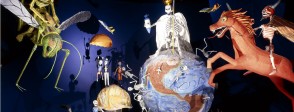
The Atomic Apocalypse
The Mexican festival of the Day of the Dead is a sophisticated and complex expression of human feelings about life and death. In celebrations of the Day of the Dead, skeletons and other grotesque creatures often appear in scenes which are used for social and political satire. The figures in the Linares family’s The Atomic Apocalypse delicately walk the balance between laughter and fear, reflecting humankind’s enduring uncertainty in the face of its own vulnerability. The Atomic Apocalypse is an assemblage of 132 figures and objects which includes references to actual events and areas of political conflict, such as the bombing of Hiroshima and Nagasaki in 1945, the Biafran War (1966 – 70) and the regime of Ayatollah Khomeini (1901 – 89) in Iran. The Biblical Four Horsemen of the Apocalypse are here represented in a contemporary manifestation of the eternal fear of War, Pestilence, Famine and Death. Over the centuries religion and science have vied to provide reassurance about such matters, all too often in conflict with each other.
War
The social liberation associated with the AD 1960s took place against a background of increasing global tension and anxiety. The Bay of Pigs Invasion in 1962 and the ensuing Cuban Missile Crisis launched the western world into a prolonged period of fear at the prospect of a third world war even more catastrophic than the first two. The notion of nuclear deterrence, predicated on the principle of mutually assured destruction, left the world’s fate resting in the hands of successive leaders and presidents of the Soviet Union and the United States. Despite intermittent periods of détente and the signing of Strategic Arms Limitation Treaties (SALT), the threat of nuclear conflict remained the backdrop to international relations through to the collapse of the Soviet Union in the early 1990s. While the weapons arsenals remain intact, the threat of nuclear war has ceded the spotlight to the no less real, but less obviously cataclysmic threat of global terrorism.
Pestilence
Human Immunodeficiency Virus and Acquired Immune Deficiency Syndrome (HIV/AIDS) is thought to have originated in Africa. It was in Kinshasha in present-day Democratic Republic of Congo that the first epidemic occurred in the 1970s, followed by a more widespread and devastating outbreak in East Africa in the 1980s. However, it was the identification of HIV/AIDS in the United States around the same time that lent it its apocalyptic character in the western imagination. This was a disease that knew no boundaries in an ever-shrinking world of easy travel and inter-communication. An added dimension came from the fact that the first American cases were identified in groups of gay men and intravenous drug users. Despite quickly emerging evidence that the condition was also transmitted through heterosexual relations and unsafe use of hypodermic needles in both drug-taking and medical situations, conservative sectors of society around the world took the opportunity to portray it as a form of divine or secular retribution for blasphemous or immoral behaviour.
Famine
For westerners who had emerged into affluence after the austerity of the post-war years, images of famine in other parts of the world were shocking. The Biafran famine of the late 1960s, the famine in Bangladesh in 1974 and the Ethiopian famine of 1983 – 5 were all viewed with huge public sympathy and relief programmes and fundraising projects were organised by governments and non-governmental agencies. At the same time, all three disasters could be seen as distant humanitarian problems, attributable to regional factors such as persistent drought or to specific policies of local governments.
However, in the later 12th and the early 21st centuries, there has been a growing realisation that the developed world has been complicit in the difficulties and disasters that affect other parts of the world. According to recent figures from the World Food Programme, one ninth of the world’s population do not have enough food to lead a healthy active life, yet world agriculture produces enough food to provide every head of population with at least 2,700 calories per day. Production, distribution, consumption and waste are overwhelmingly weighted towards the developed countries of the world.
The global Apocalypse
Concern at the environmental impact of human activity has been present in western developed countries since the early 1960s. It rose to particular prominence in the 1970s and 1980s with the increase in the development of nuclear power stations and incidents such as the accident at Three Mile Island in the USA in 1979 and at Chernobyl in the USSR in 1986. Worries about nuclear pollution specifically have given way to a more general concern about changes in climatic patterns caused by industrial, urban and certain forms of agricultural development. Climate change is increasingly accepted not just as a cause of hunger and poverty in distant parts of the world, but as a direct threat to lifestyles in developed countries.
More information
"The Atomic Apocalypse" by the Linares Family
http://www.britishmuseum.org/explore/highlights/highlight_objects/aoa/t/the_atomic_apocalypse.aspx
Selection of individual figures from "The Atomic Apocalypse"
http://www.britishmuseum.org/research/collection_online/search.aspx?images=true&people=8214
Information about the Day of the Dead in Mexico
http://www.mexicansugarskull.com/support/dodhistory.html
"The four horsemen of the Apocalypse", by Albrecht Durer
http://www.britishmuseum.org/explore/highlights/highlight_objects/pd/a/albrecht_d%C3%BCrer_four_horsemen.aspx
Outline history of nuclear energy
http://world-nuclear.org/info/Current-and-Future-Generation/Outline-History-of-Nuclear-Energy/
Short history of the Campaign for Nuclear Disarmament
http://www.cnduk.org/about/item/437
Detailed history of the nuclear bomb with a section on the Cold War and many resources
http://atomicarchive.com/
Article on the concept that disease is a form of divine retribution with reference to Ebola
http://www.newscientist.com/article/dn26092-blaming-ebola-on-gods-wrath-is-worse-than-you-think.html?full=true#.VJO5W_-ZCA
Overview and history of HIV/AIDS in different regions
http://www.avert.org/global-hiv-aids-epidemic.htm
HIV/AIDS in Sub-Saharan Africa
http://www.globalissues.org/article/90/aids-in-africa
World Health Organization HIV website
http://www.who.int/hiv/en/
Review of a book on the history of famines
http://origins.osu.edu/review/famine-short-history
More information
-
"The Atomic Apocalypse" by the Linares Family
Source: britishmuseum.org
-
Selection of individual figures from "The Atomic Apocalypse"
Source: britishmuseum.org
-
Information about the Day of the Dead in Mexico
Source: mexicansugarskull.com
-
"The four horsemen of the Apocalypse", by Albrecht Durer
Source: britishmuseum.org
-
Outline history of nuclear energy
Source: world-nuclear.org
-
Short history of the Campaign for Nuclear Disarmament
Source: cnduk.org
-
Detailed history of the nuclear bomb with a section on the Cold War and many resources
Source: atomicarchive.com
-
Article on the concept that disease is a form of divine retribution with reference to Ebola
Source: newscientist.com
-
Overview and history of HIV/AIDS in different regions
Source: avert.org
-
HIV/AIDS in Sub-Saharan Africa
Source: globalissues.org
-
World Health Organization HIV website
Source: who.int
-
Review of a book on the history of famines
Source: osu.edu


